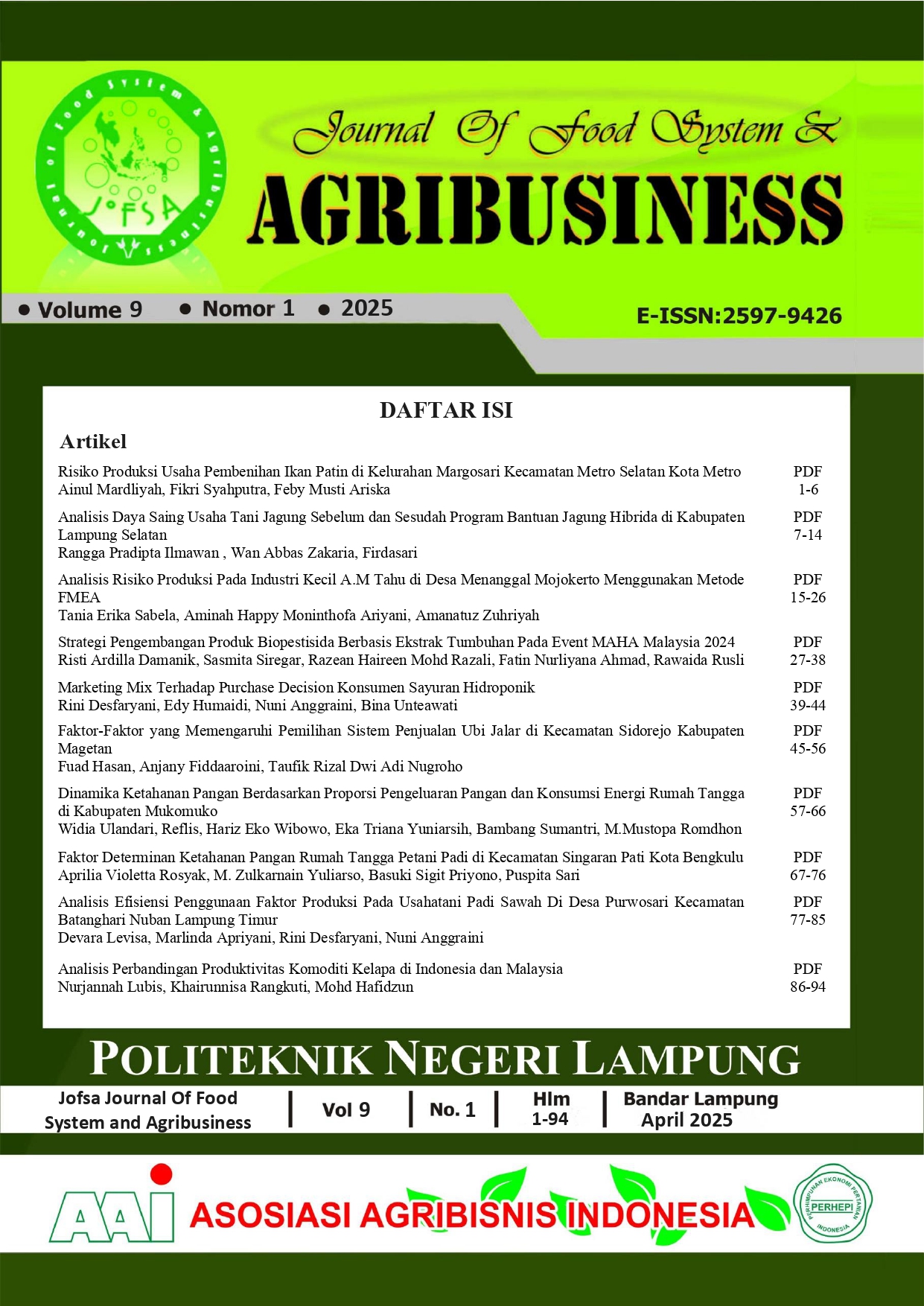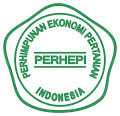Indonesia Strategi Pengembangan Produk Biopestisida Berbasis Ekstrak Tumbuhan Pada Event MAHA Malaysia 2024
DOI:
https://doi.org/10.25181/jofsa.v9i1.3939Keywords:
Biopesticide, Eco-friendly Product, SWOTAbstract
This research aims to analyze the marketing strategy of plant extract-based biopesticides, focusing on the challenges faced in the market, as well as consumer perceptions of natural products. In addition, the study also aims to capitalize on opportunities arising from the growing awareness of environmentally friendly agriculture and the trend in demand for organic products. Using SWOT analysis, primary data was collected through interviews and surveys conducted with producers and consumers. The data was then analyzed using the IFE and EFE matrix to evaluate internal factors such as strengths and weaknesses and external factors such as opportunities and threats. The results of this study show that the main strength of biopesticides lies in their environmentally friendly and health-safe nature, while the weakness is the high cost of production. Significant opportunities arise from the increasing demand for organic products despite having to compete with chemical pesticide products that already have a name in the market. This study confirms that SWOT analysis provides an effective strategic framework to improve the competitiveness of biopesticides. This strategy not only strengthens the product's position in the market, but also supports environmental sustainability and meets the global need for organic agriculture and provides a basis for the development of more innovative and applicable marketing strategies.Downloads
References
A.A. Istri, C. D., & Rizki Fadila. (2023). Uji Validitas dan Reliabilitas Kuesioner Pengetahuan Masyarakat Tentang Program JKN. Jurnal Kesehatan Qamarul Huda, 11(1), 307–315. https://doi.org/10.37824/jkqh.v11i1.2023.462
Dimat, N. V., Imung, S., Meleng, N. S., & Bahagia, M. E. (2024). Pembuatan Pestisida Nabati Bawang Putih dan Ekstra Daun Jeruk Nipis Pada Kelompok Tani Rajawali Kelurahan Karot Kabupaten Manggarai Making Vegetable Pesticides from Garlic and Lime Leaf Extra in the Rajawali Farmers Group , Karot Village , Manggarai Regen. 9(3), 823–829.
Gessalofa, R., Turgarini, D., & Ningsih, C. (2024). Analisis SWOT : Faktor Internal dan Eksternal pada Pengembangan Usaha Agrowisata ( Studi Kasus di Kopi Luwak Cikole , Kabupaten Bandung Barat ). Jurnal Hospitaliti Dan Pariwisata, 5(1), 49–57.
Husain, N. A., Abas, N., Norhisham, N., & Ariffin, N. A. (2021). The Cross Over Process of Employees’ Dedication on Visitors’ Satisfaction using UWES Work Engagement Model: A Case on MAHA Expo 2018. International Journal of Academic Research in Business and Social Sciences, 11(9). https://doi.org/10.6007/ijarbss/v11-i9/11110
Kania Rosmawati, Fatimah Azzahra, dan M. R. A. F. (2024). Analisis pengaruh penerapan strategi bauran pemasaran terhadap keputusan pembelian pada umkm serba nanas alam sari subang jawa barat. 12(2), 279–288.
Nuraida, N., Hutagaol, D., & Hariani, F. (2022). Biopestisida pengendali hama dan penyakit tanaman padi ramah lingkungan di Desa Pardamean Kecamatan Tanjung Morawa Kabupaten Deli Serdang. Jurnal Derma Pengabdian Dosen Perguruan Tinggi (Jurnal DEPUTI), 2(2), 102–105. https://doi.org/10.54123/deputi.v2i2.177
Qanita, A. (2020). Analisis Strategi Dengan Metode Swot Dan Qspm (Quantitative Strategic Planning Matrix): Studi Kasus Pada D’Gruz Caffe Di Kecamatan Bluto Sumenep. Komitmen: Jurnal Ilmiah Manajemen, 1(2), 11–24. https://doi.org/10.15575/jim.v1i2.10309
Sanaky, M. M. (2021). Analisis Faktor-Faktor Keterlambatan Pada Proyek Pembangunan Gedung Asrama Man 1 Tulehu Maluku Tengah. Jurnal Simetrik, 11(1), 432–439. https://doi.org/10.31959/js.v11i1.615
Siti, H., Sabran, A., Abas, S., Mazian, M., Devi, S., & Abstrak, S. (2020). Amalan Penggunaan Racun Perosak dalam Kalangan Pesawah di Pulau Pinang Pesticide Use’s Behaviour among Farmers at Pulau Pinang. Akademika, 90, 5–19. https://doi.org/10.17576/akad-2020-90IK1-01
Syarifah, R. N. K. (2020). Pemanfaatan Gulma Mimosa invisa sebagai Pengendali Organisme Pengganggu Tanaman. 16(2).
Widiati, S., & Septianingsih, dan I. (2024). Kumbili Farming Development Strategy as a Local Food Commodity in Pandeglang Subdistrict. Journal of Food System and Agribusiness (JoFSA), 8(1), 33–45.
Yaqin, A. A. (2021). Analisis Swot Dalam Strategi Pengembangan Usaha Kerupuk Rumahan Di Ud. Sumber Abadi Tanggulangin. JISO : Journal of Industrial and Systems Optimization, 4(2), 81. https://doi.org/10.51804/jiso.v4i2.81-87
Yusup, I. R., Kurniawan, D., Julianti, D. R., Fakhriah, L., & Awalliyah, L. N. (2022). Biopestisida Dari Ekstrak Dedaunan Untuk Membasmi Hama Tanaman Di Jawa Barat. AGROTEK: Jurnal Ilmiah Ilmu Pertanian, 5(2), 24–29. https://doi.org/10.33096/agrotek.v5i2.164
Zamsiswaya, Miswanto, Darsyah, S., & Swalauddin. (2023). Model Deskriptif Manajemen Strategik :Proses Manajemen Strategik, Lingkungan Eksternal, Lingkungan Internal, Formulasi Strategi. Jurnal Adzkiya, VII(I), 46–58.
Downloads
Published
How to Cite
Issue
Section
License
Copyright (c) 2025 Journal of Food System and Agribusiness

This work is licensed under a Creative Commons Attribution-NonCommercial 4.0 International License.
With the receipt of the article by the Journal of Food System and Agribusiness Editorial Board and the decision to be published, then the copyright regarding the article will be diverted to the Journal of Food System and Agribusiness.
Politeknik Negeri Lampung as the publisher of the Journal of Food System and Agribusiness holds the copyright regarding all the published articles in this journal.
Politeknik Negeri Lampung has the right to multiply and distribute the article and every author is not allowed to publish the same article that was published in this journal.
The manuscript authenticity and copyright statement submission can be downloaded ON THIS FORM. Fill out the form and submit as a supplementary file.
All publications by Journal of Food System and Agribusiness is licensed under a Creative Commons Attribution Non-Commercial 4.0 International License.
























